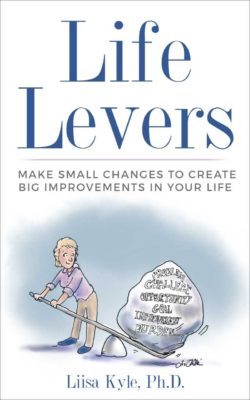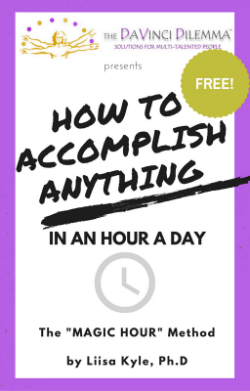 It’s perfectly natural for multi-talented people to have lots of stuff around — sources of inspiration, supplies, projects and products for every one of their talents. It adds up. It can be challenging to manage it all while juggling all the activities you’ve got going on. If your creative workspace is tidy and well organized, congratulations! You’re reaping the benefits – you’re saving time and energy and being more creative while avoiding distractions and procrastination. If that isn’t the case, however…if you can’t find what you need when you need it…if your ‘piling’ system has gotten out of hand….if your work surface is groaning under an avalanche of clutter…if your studio looks like is should be featured on the TV reality show Hoarders…then it’s time to declutter. The challenge is to find a strategy that works for you without causing you guilt or stress.
It’s perfectly natural for multi-talented people to have lots of stuff around — sources of inspiration, supplies, projects and products for every one of their talents. It adds up. It can be challenging to manage it all while juggling all the activities you’ve got going on. If your creative workspace is tidy and well organized, congratulations! You’re reaping the benefits – you’re saving time and energy and being more creative while avoiding distractions and procrastination. If that isn’t the case, however…if you can’t find what you need when you need it…if your ‘piling’ system has gotten out of hand….if your work surface is groaning under an avalanche of clutter…if your studio looks like is should be featured on the TV reality show Hoarders…then it’s time to declutter. The challenge is to find a strategy that works for you without causing you guilt or stress.
The DaVinci Decluttering Method™ is designed to do precisely that:
Step One: Abandon guilt.
Recognize that clutter is often a natural byproduct of being a multi-talented person. It’s nothing to be ashamed of. Please avoid beating yourself up about the state of your creative workspace. If, however, clutter is interfering with your talents (and happiness), it’s time to move to Step Two.
Step Two: Verify your Motivation
It’s impossible to declutter without the proper motivation. Decluttering can be daunting. It can be a lot of physical work…and is often surprisingly emotional. The clutter we collect reflects and represents our past memories, our present lives as well as our future plans and dreams. (Those aren’t a bunch of rocks — they’re souvenirs from traveling through 51 countries. Those may look like bits of broken pottery, but really they are a future mosaic, etc.).
You can’t declutter because you think you ‘should’ do so. You can only declutter if you’re really ready to change. The DaVinci Decluttering Method™ addresses this in two ways — first, by having you create a clear, pleasing, innovative alternative to your current cluttered space and second by addressing any underlying issues contributing to the present mess.
First, imagine your perfect creative workspace. If you could wave a magic wand and instantly transform your current room into the studio of your dreams, what would it be like? Be detailed: what sights, sounds, textures and scents do you envision? What would you really love to have in this space, if only it wasn’t so selfish/silly/expensive? How would this kind of ideal workspace feel? What would be the impact on your creative work?
Second, look around at your present circumstances. What is your clutter costing you, in terms of time, energy, space and productivity?
Third, and most important: Are you ready to change? Are you willing to give up some of what’s around you? Are you really ready to shift things away from their current state and towards your dream workspace? If yes, read on. If no, it’s not time to tackle your decluttering yet. Avoid forcing yourself to take action now…you’re unlikely to succeed and apt to feel guilty, stressed and cross with yourself. (When you are ready, come on back).
Step Three: Investigate New Options
If your creative workspace isn’t working well for you, it’s helpful to consider some alternatives. Seek inspiration online. For example here are dozens of photos of artists’ studios.
Visit an office supply store, an organizational aid shop and also your favorite art supply warehouse. Look for new ways to organize your supplies, materials, products and ideas. For example, if you’re a visual organizer and/or more of a ‘piler’ than a ‘filer’, you can replace your unused, empty filing cabinet with a ‘paper organizer’ — stacks of cubbies into which you can pile your relevant projects. On the other hand, if your piles are too distracting, you may need to hide them: consider using cupboards or bookshelves attached with opaque doors.
Flip through the IKEA catalog — odds are high that those clever Scandinavians have devised solutions to your particular organizational challenges.
Incorporate the ideas that appeal the most into your ‘dream workspace’ plan.
Step Four: Explore What’s Really Going On
If you’re reading this article, you are probably a creative person with a lot of talents who is seeking creative solutions to clutter. If it was just a matter of buying some organization aids and putting things into piles called “Keep”, “Donate”, “Sell” or “Toss”, you would have done it already.
So why haven’t you? Because this is not just random ‘stuff’. This is your stuff — each piece of clutter has its own history, purpose and emotional baggage. You need to understand what underlies your clutter problem, before you can declutter effectively.
(a) Why is this clutter here?
You might know already. Maybe you have difficulty organizing your paperwork and need solutions for that. Perhaps you’re clinging to past chapters of your life…and/or are fearful of the future. It might be that you have experienced scarcity (or fear of lack) and so have difficulty getting rid of things. Maybe you’re a shopaholic. Perhaps, like me, you can’t walk into an art or craft supply place without spending at least $200. (Damn the siren call of the bead aisle!) It could be that you have a tendency to start projects, then abandon them before their done. Off the top of your head, what do you suspect is contributing to your clutter?
(b) Take a random survey of your clutter. Be like an archeologist surveying a new dig. What’s there? Are there items representing the past? Are there disorganized supplies? Random papers? Half-done projects? Make a list of the different kinds of clutter you have.
If this jives with your answers to (a), yay! You’re on the way to a clutter-free path. For each clutter problem you’ve detected, devise relevant solutions. For example, if you have a bunch of supplies that need organizing, then you could pull them out and use some of the ideas you collected from Step Three to corral them. Then look at what’s left in your clutter pile and repeat the process.
If you’re finding new issues, yay! You’re getting closer to the answers that will work for you. Identify what’s going on and, for each, devise solutions.
If you’re still in the dark, take a step back and ask again: what is going on here? Listen to your gut. If you focus long enough, you should be rewarded with an epiphany or two. “Oh! I can’t keep my financial papers in order because I’m repulsed by crass, clerical monetary matters — it’s not who I am.” OR “I’m an artist! My workspace is supposed to crazy and chaotic! It feels wrong to be tidy.” OR “I can’t get rid of those cassettes I never listen to because they represent the happiest time of my life.” If you find yourself getting emotional, you’ve hit it: the crux of the matter. Congratulations! You’re there. This is the critical question: Which is more important to you? Your current situation (including the underlying beliefs) or your vision of your wonderful new workspace? If you’re ready to let go of what’s been keeping you stuck in clutter, proceed to Step Five. If not, you’re not ready yet. Take your time and come on back when you are.
Step Five: Pick a Decluttering Strategy that will Work for You
Now that you know what’s really going on…and have solutions to the different aspects of your clutter problems, the decluttering process should be much, much easier.
Just a few more choices to make: Will it be easier for you to tackle a little bit at a time? Or do you need more of a radical Shock & Awe approach to make a difference? If the latter seems overwhelming, then go at it, slowly but surely, in bite sized bits. If you think you need to take more drastic action, then do it all at once. (Details below).
Whether fast or slow, the basic process is to go through your ALL things and sort them. Use the categories that will work for you. For example:
By action: “Keep”, “Sell”, “Donate”, “Toss”
By chronology: “Past” “Present” “Future” — or “Yesterday” “Today” “Tomorrow”
By emotion: “Hate it” “Like it” “Love it”
By talent: “Painting” “Welding” “Banjo” “Songwriting”
By function: “Inspiration” “Supplies” “Products” “Business Materials”
By clutter problem: “Papers to organize” “Supplies to organize” “Items representing my Past” “Half-done projects”
*****
If you opt for the Radical Shock & Awe Decluttering, you’d first go through the preceding steps of the DaVinci Decluttering Method™. When you’re ready to proceed, remove everything from your creative workspace — the furniture, the decor, the supplies, the papers — everything. Put it anywhere else.
Start with a clean slate. Begin by creating as much of your dream workspace as possible — paint and decorate it the way you want.
Install the minimum necessary furniture — a place to work plus items to hold your supplies for each of your key talents. If you have furniture pieces already that work well, keep them. If they don’t, sell them or donate them and invest in other furniture that will better suit your needs. If cost is an issue, try CraigsList for bargains. Note: you’re not trying to fill the space. You’re just putting in a few key building blocks — the essentials. Later, you’ll probably be adding more organizational aids, as you figure them out. How does your space feel? If delightful, it’s time to move on. If not, what adjustments can you make to create a more pleasant space?
Once you’re happy to be in your creative workspace, it’ll be so much easier to sort through your stuff. Start anywhere. Pick a box or pile and go through the contents. Sort it into piles that work for you. Toss, donate or sell what you don’t need or want. Organize and place what you want to keep.
Before you know it, you’ll be enjoying you’re new, clutter-free space.
*****
What about you? Please use the comment box below to share your decluttering tips and stories.
*****
 Want more tips and techniques for getting things done? Check out my book YOU CAN GET IT DONE: Choose What to do, Plan, Start, Stay on Track, Overcome Obstacles, and Finish
Want more tips and techniques for getting things done? Check out my book YOU CAN GET IT DONE: Choose What to do, Plan, Start, Stay on Track, Overcome Obstacles, and Finish
Available here in paperback and eBook fomats: http://bit.ly/YouCanGetItDone
*****
If you’d like to share or publish this article, you may, if you include the author’s name, a link to this original post and the following text blurb:
Are you struggling with too many talents, skills, ideas? You may have The DaVinci Dilemma™! Find tools, fun quizzes, coaching, inspiration and solutions for multi-talented people at http://www.davincidilemma.com/.




Wow, long post… and very informative. 🙂
A strategy is very important for decluttering, isn’t it?
You can’t just decide on day that you’ll take time off and deal with it all in one go. Invariably, that time off you’re imagining to be about 30 seconds, is actually several hours, or possibly several days.
David@lettinggoofclutter recently posted..How To Declutter Fast
Sometimes guilty feeling well always overcome us. Specially when we do multitasking and are not really used of cluttered task. I like the idea that you presented here at your blog. I might as well try the tips you shared.
maxhine anne recently posted..How do i win the lottery?
I always work on a very organized place. I just can’t focus much when there are so much clutter around, even with my computer. I always put unnecessary info on the recycle bin. I have this obsessive compulsive around me, so I have this urge to clean up most often.
hopey1 recently posted..lyrics
If you have furniture pieces already that work well, keep them. If they don’t, sell them or donate them and invest in other furniture that will better suit your needs. | 😛
malunggay56 recently posted..most effective hcg diet plan